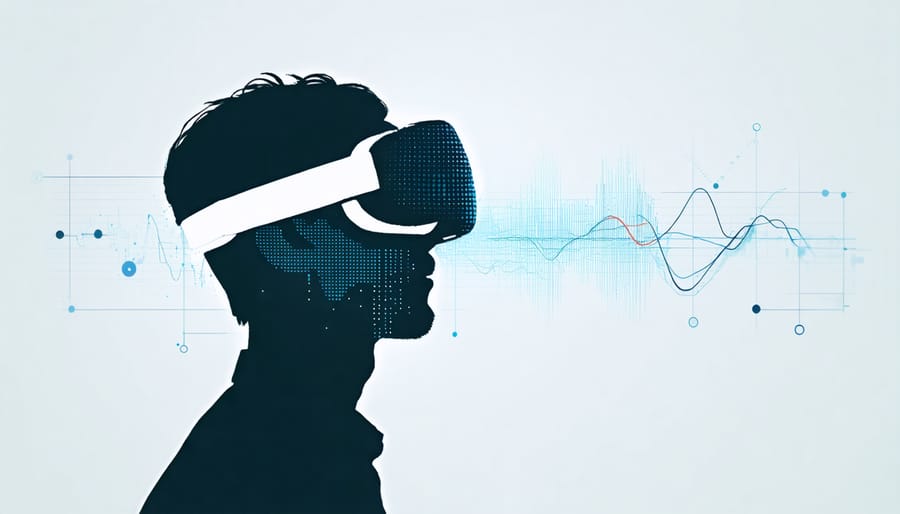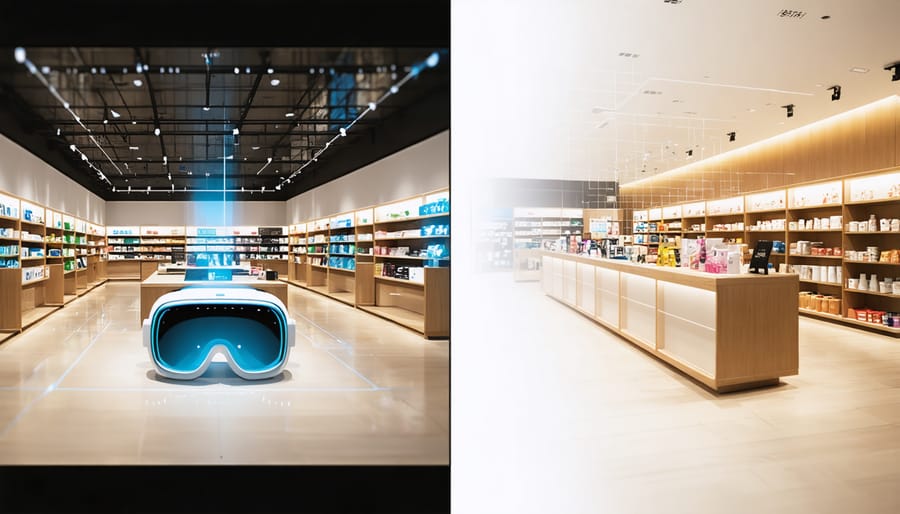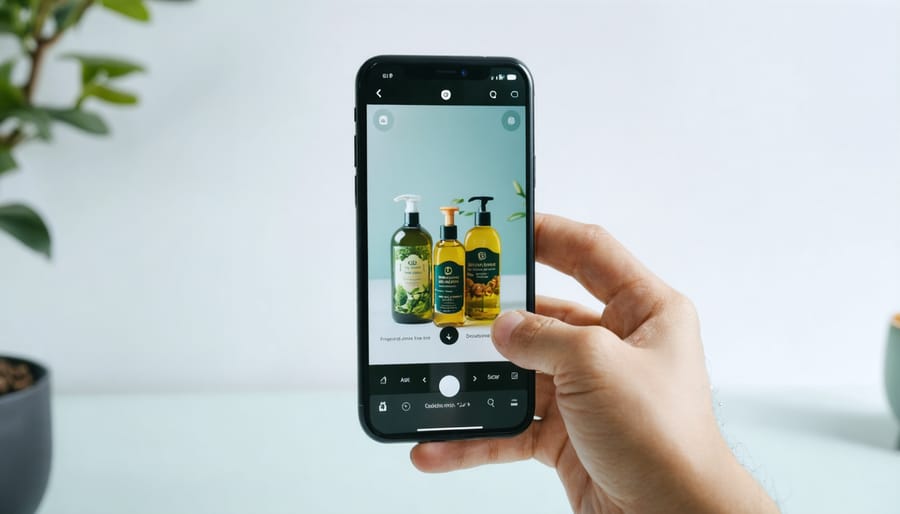VR & AR Transform Brand Stories into Memorable Customer Experiences

Virtual reality and augmented reality are revolutionizing how businesses transform customer experience through immersive storytelling. By combining sensory engagement, interactive narratives, and spatial computing, organizations now create memorable brand experiences that drive measurable results. Recent data shows that immersive content generates 32% higher engagement rates and a 70% increase in emotional response compared to traditional media formats.
For marketing professionals and business leaders, immersive storytelling represents more than just technological innovation – it’s a powerful tool for achieving concrete business objectives. Whether deploying VR product demonstrations that boost conversion rates, creating AR retail experiences that reduce return rates, or developing mixed-reality training programs that cut onboarding costs, the applications are both practical and profitable.
This shift toward immersive content isn’t just changing how stories are told; it’s fundamentally altering how customers interact with brands, make purchasing decisions, and form lasting connections with products and services. As hardware costs decrease and development platforms become more accessible, businesses of all sizes can now leverage these technologies to create compelling narratives that resonate with their target audience and deliver tangible ROI.
Why Immersive Brand Storytelling Matters Now
The Psychology Behind Immersive Experiences
The human brain processes immersive experiences differently from traditional media, creating deeper neural pathways and stronger emotional connections. When audiences are fully engaged in a story through multiple senses, their brains release chemicals like dopamine and oxytocin, enhancing memory formation and emotional bonding.
This psychological engagement translates directly to brand impact. Studies show that immersive storytelling experiences result in up to 27% higher emotional engagement and 34% better message recall compared to traditional marketing methods. By placing customers at the center of your narrative, you create a personal stake in the story’s outcome, leading to stronger brand associations and increased loyalty.
The power lies in what psychologists call “presence” – the feeling of being physically and emotionally present in a virtual environment. When customers experience this state, they’re more likely to form authentic connections with your brand message and retain information about your products or services. This heightened engagement creates memorable experiences that customers are more likely to share with others, amplifying your marketing reach through word-of-mouth recommendations.

Impact on Customer Engagement Metrics
Recent studies reveal compelling data on the business impact of immersive storytelling technologies. Companies implementing VR/AR storytelling report an average 35% increase in customer engagement time and a 27% higher conversion rate compared to traditional marketing methods. Notably, retail businesses using AR product visualization see a 40% reduction in return rates and a 65% increase in customer confidence during purchasing decisions.
The metrics show particularly strong performance in emotional connection and brand recall. Customers exposed to immersive brand stories demonstrate 74% better information retention and are 2.7 times more likely to form emotional connections with the brand. This translates to tangible business outcomes, with an average 23% increase in customer lifetime value among businesses utilizing these technologies.
Social sharing metrics also see significant improvements, with immersive content generating 1.8 times more shares than traditional media. Dwell time increases by an average of 5-7 minutes when AR elements are incorporated into marketing campaigns, while customer feedback indicates a 42% higher satisfaction rate with immersive experiences compared to conventional marketing approaches.
These metrics underscore the growing importance of immersive storytelling in modern marketing strategies, particularly for businesses looking to differentiate themselves in competitive markets.
Practical VR Applications in Brand Storytelling
Virtual Product Experiences
Modern brands are revolutionizing customer engagement through virtual product experiences that transform traditional showcases into interactive journeys. Companies like IKEA and BMW have pioneered this approach, allowing customers to explore products in immersive 3D environments before making purchase decisions.
These virtual showrooms enable customers to interact with products from any location, examining details, customizing features, and experiencing functionality in ways that flat images or videos cannot match. For example, furniture retailers let customers virtually place items in their homes, while automotive companies offer virtual test drives and customization experiences.
The benefits extend beyond convenience. Virtual catalogs reduce overhead costs associated with physical showrooms while providing valuable data on customer preferences and interaction patterns. Businesses report increased conversion rates when implementing VR product demonstrations, with some seeing up to 40% improvement in purchase confidence.
Key implementation strategies include:
– Creating detailed 3D product models with accurate textures and scale
– Developing intuitive interaction mechanics
– Ensuring cross-platform compatibility
– Incorporating realistic physics and lighting
– Adding interactive customization options
For smaller businesses, starting with simpler AR solutions through mobile devices can provide a cost-effective entry point before investing in full VR experiences. This approach allows companies to test customer reception and refine their virtual showcase strategy while maintaining budget efficiency.
Virtual Brand Environments
Virtual brand environments represent a groundbreaking approach to customer engagement, combining digital technology with traditional retail concepts to create immersive shopping experiences. These environments allow businesses to transcend physical limitations while maintaining the personal touch that customers value.
By leveraging virtual and augmented reality technologies, brands can create compelling digital spaces where customers can interact with products, explore brand stories, and make purchases in ways previously impossible. These virtual stores offer 360-degree product views, customizable environments, and interactive features that enhance the shopping experience.
Key elements of successful virtual brand environments include:
– Intuitive navigation systems that mirror familiar shopping patterns
– Realistic product demonstrations and visualization
– Interactive touchpoints that provide detailed product information
– Seamless integration with e-commerce platforms
– Personalized customer experiences based on preferences and behavior
For businesses, virtual environments offer significant advantages:
– Reduced overhead costs compared to physical retail spaces
– Global accessibility without geographical constraints
– Real-time analytics and customer behavior tracking
– Ability to quickly update products and promotional content
– Enhanced opportunities for customer engagement and feedback
When implementing virtual brand environments, focus on creating authentic experiences that align with your brand identity while providing practical value to customers. Start with clear objectives, ensure technical accessibility, and continuously gather user feedback to refine the experience.
Remember that virtual environments should complement, not replace, existing customer touchpoints, creating a cohesive omnichannel strategy that meets modern consumer expectations.

AR: Making Brand Stories Part of Daily Life
Location-Based AR Experiences
Location-based AR experiences are transforming how brands connect with audiences in specific physical spaces, creating memorable interactions that blend digital content with real-world environments. By implementing targeted AR engagement strategies, businesses can deliver contextually relevant stories that resonate with customers on a deeper level.
Major retailers are leading this trend by developing AR store navigation apps that guide customers while sharing product stories and brand heritage. For instance, museums and cultural institutions use AR to bring historical narratives to life, allowing visitors to witness past events unfold in the exact locations where they occurred.
Restaurant chains have successfully implemented AR menu experiences that showcase dish preparation processes and ingredients directly at the dining table. Real estate companies utilize AR to help potential buyers visualize property improvements and community developments while standing at the actual location.
The key to successful location-based AR storytelling lies in understanding your audience’s physical context and creating content that adds genuine value to their experience. Consider these practical applications:
– Retail wayfinding with embedded product storytelling
– Historical site tours with AR reconstructions
– Interactive city guides with local business narratives
– Event-specific AR activations at venues
– Location-triggered brand stories at points of interest
When implementing these experiences, ensure content is easily accessible, technically reliable, and provides clear value to users in that specific location.
Interactive Product Packaging
Interactive product packaging through augmented reality (AR) is revolutionizing how brands connect with consumers at the point of purchase. By transforming traditional packaging into dynamic storytelling platforms, businesses can create memorable experiences that extend beyond the physical product.
Companies can now embed AR markers or QR codes onto their packaging that, when scanned with a smartphone, bring products to life through interactive narratives, 3D animations, or educational content. For example, wine bottles can showcase the vineyard’s story and winemaking process, while toy packaging can demonstrate product features through animated demonstrations.
This technology offers several business advantages. First, it provides valuable product information without cluttering the physical packaging. Second, it creates an engaging experience that can influence purchasing decisions right at the shelf. Third, it generates valuable data about consumer interaction and engagement patterns.
To implement AR packaging effectively, consider these key elements:
– Clear call-to-action prompts that guide users to scan the package
– Compelling content that adds genuine value to the customer experience
– Simple user interface requiring minimal steps to access the content
– Mobile-optimized experiences that work across different devices
– Measurable metrics to track engagement and ROI
The most successful AR packaging implementations focus on storytelling that enhances the product experience rather than just adding technological novelty. When done right, this approach can significantly increase brand engagement, product understanding, and customer loyalty while providing a competitive edge in retail environments.

Implementation Strategies for Businesses
Getting Started with Minimal Investment
Getting started with immersive storytelling doesn’t require a massive budget or advanced technical expertise. Begin with 360-degree photos and videos, which you can capture using smartphones and affordable 360-degree cameras. These tools allow you to create engaging virtual tours and interactive product demonstrations for under $500.
Free or low-cost platforms like ThingLink and H5P enable you to add interactive elements to your existing content. Start by enhancing your product photos with clickable hotspots or transforming your company timeline into an interactive journey. These platforms offer user-friendly interfaces and require minimal technical knowledge.
For augmented reality experiences, explore entry-level AR creation tools like Spark AR Studio or Lens Studio. These free platforms let you create basic AR filters and experiences for social media, helping you test audience engagement before investing in more sophisticated solutions.
Consider starting with web-based VR experiences that work on standard browsers, eliminating the need for specialized hardware. Tools like A-Frame allow you to create simple virtual environments that customers can explore using their smartphones or computers.
Begin small, measure audience response, and scale your immersive storytelling efforts based on concrete results.
Measuring Success and ROI
To effectively evaluate the success of immersive storytelling campaigns, businesses need to establish clear metrics and measurement frameworks. Start by defining specific KPIs aligned with your campaign objectives, whether they’re engagement rates, conversion metrics, or brand awareness indicators. Key metrics to track include user engagement time, interaction rates, completion rates for immersive experiences, and social sharing statistics.
When it comes to measuring marketing ROI, combine both quantitative and qualitative data. Track direct revenue attribution through sales conversions, but also measure softer metrics like brand sentiment and customer feedback. User behavior analytics, such as heat maps and interaction patterns, provide valuable insights into how audiences engage with your immersive content.
Consider implementing A/B testing between traditional and immersive storytelling approaches to demonstrate comparative effectiveness. Use analytics tools specifically designed for AR/VR experiences to capture accurate data. Regular monitoring and reporting help optimize campaign performance and justify investment in immersive technology. Remember to measure both short-term impact and long-term value creation to build a comprehensive understanding of your campaign’s success.
As we’ve explored throughout this article, immersive storytelling represents a transformative approach to customer engagement and brand communication. The convergence of virtual and augmented reality technologies with traditional marketing strategies has opened up unprecedented opportunities for businesses to create memorable, emotionally resonant experiences for their audiences.
The key to success lies in maintaining a balance between technological innovation and authentic storytelling. While the tools and platforms will continue to evolve, the fundamental principles of engaging narrative and customer-centric content remain paramount. Businesses that can effectively combine these elements while maintaining clear objectives and measurable outcomes will be best positioned to leverage immersive storytelling for tangible results.
Looking ahead, we can expect to see more accessible and cost-effective solutions emerging for small and medium-sized businesses. The democratization of immersive technologies, coupled with increasing consumer familiarity and acceptance, suggests a bright future for this marketing approach.
To stay competitive in this evolving landscape, businesses should:
– Start small but think strategically
– Focus on creating genuine value for their audience
– Regularly measure and analyze engagement metrics
– Stay informed about emerging technologies and best practices
– Maintain flexibility in their implementation approach
The future of immersive storytelling isn’t just about technology – it’s about creating meaningful connections with your audience in ways that were previously impossible. By embracing these new possibilities while staying true to your brand’s core message, you can develop compelling experiences that resonate with your audience and drive real business results.
Leave a Reply